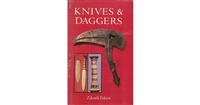 Knives and Daggers. Factor.
Knives and Daggers. Factor.
A Guide for Collectors, with terminology, identification and classification, and a survey of construction, function and development.
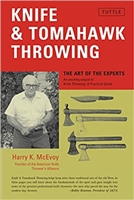 Knife & Tomahawk Throwing: The Art of the Experts. McEvoy.
Knife & Tomahawk Throwing: The Art of the Experts. McEvoy.
"Knife & Tomahawk Throwing helps keep alive these traditional arts of the old West. In these pages, you will learn about the fundamentals of the sport and gain insight into some of the greatest professional knife throwers–the men who paved the way for the modern day thrower." — Bobby Branton, President of the American Knife Thrower's Alliance (AKTA)
Harry McEvoy, the foremost expert in the field of tomahawk and knife throwing and best-selling author of Knife Throwing: A Practical Guide, provides us with an exciting, in-depth look at the popular sport of weapon throwing.
Meet the men who throw flaming knives at lovely ladies on a spinning target—and not scorch a hair; learn about the legendary "Skeeter" Vaughan, whose record-breaking throw saved the lives of hundreds of U.S. servicemen during World War II; and witness the courage of Tony Cascarella, who brought down a 275-pound wild boar with only three Bowie-Axe throwing knives.
In addition, this book will clearly show you the skills involved in knife and tomahawk throwing—skills all the professionals first mastered before attempting the daring feats required when performing the "impalement arts." Also presented is an interesting history of throwing-knives, from the earliest times, through the development of the European daggers, and up to the knives used during the Vietnam War. Furthermore, you'll learn about many of the other throwing weapons of the world, including the martial arts weapons used by the Japanese ninja, and the deadly boomerangs of the Australian aborigines.
Concisely written and illustrated with more than 50 photographs—including many of the "greats" in action—Knife and Tomahawk Throwing is a must for anyone interested in these fascinating sports.
Chapters include:
The Fine Points of Knife Throwing
How to Build Targets
Evolution of the Throwing Knife
The Art of the Professionals
The Saga of Skeeter Vaughn
Tomahawk Throwing
The Hunt of the "Hog Heaven" Boar
The Other Throwing Instruments
 Fairbairn-Sykes. Commando Dagger. Thomson.
Fairbairn-Sykes. Commando Dagger. Thomson.
The Fairbairn-Sykes Commando dagger has become iconic as the most widely recognized fighting knife in the world. The origins of the dagger can be traced to Shanghai in the 1930s where W. E. Fairbairn and US Marine officers including Sam Yeaton carried out experiments in developing what they considered the perfect knife for close combat. 7x9 inches, 64pgs.
When Fairbairn and Sykes became instructors for the Commandos, they refined the design which would evolve into the classic Fairbairn-Sykes dagger. The dagger was first used during early Commando raids into occupied Europe but saw action in every theatre of World War II (1939-1945). US Rangers and Marines who had trained with the Commandos took their Fairbairn-Sykes daggers home which also influenced the development of American Special Forces daggers. The Fairbairn-Sykes remained in use with many units after the war, and has become a symbol of commando and special forces units throughout the world.
 Old Sword Play. Hutton
Old Sword Play. Hutton
Comprehensive, detailed instruction in the use of the two-hand sword, rapier and dagger, broadsword and buckler, rapier and cloak, and dagger and cloak, along with 59 illustrations, including diagrams and rare woodcuts, of classic fencing positions. Valuable information for scholars, sword-play enthusiasts, general readers and anyone interested in this age-old form of self-defense.
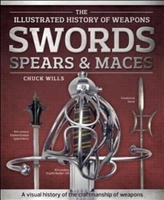 Swords, Spears and Maces. Wills..
Swords, Spears and Maces. Wills..
Discover the history and development of weaponry through the ages with The Illustrated History of Weapons series.
These comprehensive visual reference books explore the craftsmanship and progression of weaponry and cover the many important conflicts and historical events that have shaped the world we live in.
These titles feature stunning photography, fascinating biographical information and detailed insight into the technology and tactics of the battlefield, and cover the evolution of early knives and swords through to the pistols and rifles of modern times.
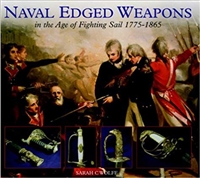 Naval Edged Weapons: In the Age of Fighting Sail 1775-1865. Wolfe.
Naval Edged Weapons: In the Age of Fighting Sail 1775-1865. Wolfe.
The particular needs of naval close-quarter combat produced distinctive versions of axes, pikes and cutlasses (not to mention the great variety of officers' fighting, presentation and dress swords) and this book surveys in full detail the whole gamut of such weapons as used in the Royal Navy and the new naval service of the United States. It concentrates on development from the outbreak of the American Revolution in 1775 to the end of the US Civil War in 1865, the apogee and decline of fighting sail, revealing how British weapons were initially a major source of inspiration for the American navy, an influence which eventually declined as the United States developed its own arms industry. Using surviving examples, artifacts recovered by archaeology, and documentary sources, the book devotes individual chapters to shipboard axes, pikes and other polearms,
 Illustrated Guide To Knives. Suermondt.
Illustrated Guide To Knives. Suermondt.
'Illustrated Guide to Knives' is written especially for collectors and enthusiasts of fine knives and for government departments and services. It covers the origin of knives as tools and weapons, deals with specific terminology and explains the technology that leads to a fine blade.
 Collectors' Guide to Swords, Daggers and Cutlasses. Weland.
Collectors' Guide to Swords, Daggers and Cutlasses. Weland.
The deadly allure of these sharp-edged weapons is analyzed in terms of their evolution, mythology, and historical significance. From all eras and from every part of the world, over 150 full colour illustrations bring extraordinary examples to the reader from the largest collections.
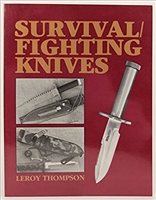 Survival/Fighting Knives. Thompson.
Survival/Fighting Knives. Thompson.
From the combat-tested, slash-and-thrust blade to me no-nonsense, general-purpose survival knife, this book shows you which type of blade suits your need best. For the man who really uses his knife, it covers utility blades, hollow-handled survival knives, survival kits, folders, combat and streetfighting knives and knife specs and evaluations.
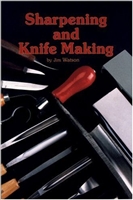 Sharpening and Knife Making. Watson
Sharpening and Knife Making. Watson
Sharpening techniques for numerous woodcarving tools and knives of various sizes and shapes, including pocket knives and kitchen knives. The necessary materials for proper sharpening are listed and discussed with methods for reconditioning and making new knives and tools and information on resurfacing the sharpening stones.
 Swiss Army Knife Camping & Outdoor Survival Guide: 101 Tips, Tricks & Uses. Lynch.
Swiss Army Knife Camping & Outdoor Survival Guide: 101 Tips, Tricks & Uses. Lynch.
Sharpen your survival skills and learn why you should keep a Swiss Army Knife with you at all times, whether you are exploring wild jungles, tall peaks, or city streets. As a handy “everyday carry” for life’s challenges, the versatile Swiss Army Knife can’t be beat. Victorinox Official Swiss Army® Knife Survival Guide shows how to use your iconic red multi-tool to handle 101 different emergency situations. From starting a fire and making a shelter to catching a fish, building a stove, or applying a splint, discover why the SAK is a must-have for every survival kit. Author Bryan Lynch includes basic advice on knife care, and reviews the many models and features currently available from Victorinox AG, makers of the Original Swiss Army Knife.
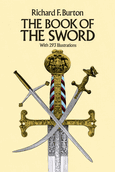 The Book of the Sword. Burton
The Book of the Sword. Burton
Eloquent, exceptionally erudite history of the "Queen of Weapons." Traces sword's origin — from prehistory to its full growth during early Roman Empire. Discusses earliest weapons of stone, bone, horn and wood as well as variations: sabre, broadsword, cutlass, scimitar and more. Enhanced by nearly 300 excellent line drawings.
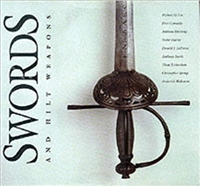 Swords and Hilt Weapons. Coe, Harris, North, La Rocca, Spring....
Swords and Hilt Weapons. Coe, Harris, North, La Rocca, Spring....
Secondhand, VGC, some scuffing to dustjacket.
A guide to nearly 4000 years of sword making from the Bronze Age to World War II. On the basis of technical excellence and cultural significance, emphasis is given to European, Islamic and Japanese weapons. It also covers those of Africa, Mesoamerica, China, Central Asia and Indonesia.
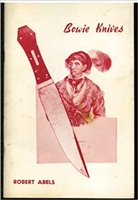 Bowie Knives. Robert Abels.
Bowie Knives. Robert Abels.
This is the most desirable of Robert Abels' pamphlets featuring all types of Bowie knives. Well illustrated with over 80 of the finest examples shown, along with with brief but authoritative descriptions. The inside cover lists Bowie knife makers by origin, with 13 American companies and 36 English makers.
 Hermann Hstorica Dagger and Knife Auction Catalogue.
Hermann Hstorica Dagger and Knife Auction Catalogue.
German Text, excellent reference
Daggers and knives from the Far East. Hermann Historica Munich 1985. 133 different daggers and knives from Far Eastern countries from approx. 1000 AC to the 19th century. 72 pages, 2 color plates, numerous black and white photos, descriptions and history of development.
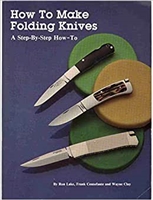 How to make Folding Knives. Lake.
How to make Folding Knives. Lake.
Follow easy instructions on how to make a folding knife. Includes safety tips, suppliers lists, and answers many questions from three top custom makers.
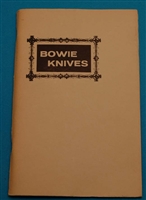 Bowie Knives. Abels.
Bowie Knives. Abels.
This is the catalog of the 1962 display that Robert Abels, noted Bowie collectors held at the Ohio Historical Society. This catalog is an early example of the books collectors used for years before the internet and general identification books we have available to us now. A great early work of some truly tremendous knives.
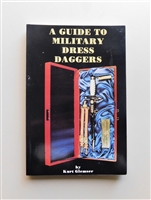 A Guide to Military Dress Daggers. Vol 1. Glemser .
A Guide to Military Dress Daggers. Vol 1. Glemser .
For the first time, the foreign daggers of both WW1 and WW2 are finally identified. In addition to the foreign pieces, Kurt also covers German Damascus makers and their tang marks, German Imperial Naval pieces, fantasy pieces, and even the current reproductions coming out of Texas. An extremely worthwhile addition to your reference library.
